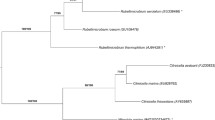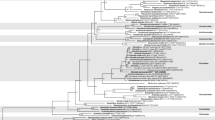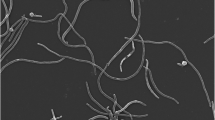Abstract
We determined the entire genome sequence of the marine bacterium Cobetia marina KMM 296 de novo, which was isolated from the mussel Crenomytilus grayanus that inhabits the Sea of Japan. The genome that provides the lifestyle of this marine bacterium provides alternative metabolic pathways that are characteristic of the inhabitants of the rhizospheres of terrestrial plants, as well as deep-sea ecological communities (symbiotic and free-living bacteria). The genome of C. marina KMM 296 contains genes that are involved in the metabolism and transport of nitrogen, sulfur, iron, and phosphorus. C. marina strain KMM 296 is a promising source of unique psychrophilic enzymes and essential secondary metabolites.
Similar content being viewed by others
References
Aziz, R.K., Bartels, D., Best, A.A., et al., The RAST server: rapid annotations using subsystems technology, BMC Genomics, 2008, vol. 9, p. 75, doi 10.1186/14712164-9-75
Balabanova, L.A., Gafurov, Y.M., Pivkin, M.V., et al., An extracellular S1-type nuclease of marine fungus Penicillium melinii, Mar. Biotechnol., 2012, vol. 14, pp. 87–95.
Balabanova, L., Golotin, V., Kovalchuk, S., et al., A novel bifunctional hybrid with marine bacterium alkaline phosphatase and Far Eastern holothurian mannanbinding lectin activities, PloS One, 2014, vol. 9, p. e112729.
Behera, B.C., Singdevsachan, S.K., Mishra, R.R., et al., Diversity, mechanism and biotechnology of phosphate solubilising microorganism in mangrove, Biocatal. Agric. Biotechnol., 2014, vol. 3, pp. 97–110.
Belcheva, N.N., Zakhartsev, M.V., Dovzhenko, N.V., et al., Anthropogenic pollution stimulates oxidative stress in soft tissues of mussel Crenomytilus grayanus, Ocean Sci. J., 2011, vol. 46, pp. 85–94.
Golotin, V.A., Balabanova, L.A., Likhatskaya, G.N., and Rasskazov, V.A., Recombinant production and characterization of a highly active alkaline phosphatase from marine bacterium Cobetia marina, Mar. Biotechnol., 2015, vol. 17, pp. 130–143.
Ibacache-Quiroga, C., Ojeda, J., Espinoza-Vergara, G., et al., The hydrocarbon-degrading marine bacterium Cobetia sp. strain MM1IDA2H-1 produces a biosurfactant that interferes with quorum sensing of fish pathogens by signal hijacking, Microb. Biotechnol., 2013, vol. 6, pp. 394–405.
Ista, L.K., Callow, M.E., Finlay, J.A., et al., Effect of substratum surface chemistry and surface energy on attachment of marine bacteria and algal spores, Appl. Environ. Microbiol., 2004, vol. 70, pp. 4151–4157.
Ivanova, E.P., Christen, R., Sawabe, T., et al., Presence of ecophysiologically diverse populations within Cobetia marina strains isolated from marine invertebrate, algae and the environments, Microbes Environ., 2005, vol. 20, pp. 200–207.
Kim, M.S., Roh, S.W., and Bae, J.W., Cobetia crustatorum sp. nov., a novel slightly halophilic bacterium isolated from traditional fermented seafood in Korea, Int. J. Syst. Evol. Microbiol., 2010, vol. 60, pp. 620–626.
Lamport, D.T.A., Kieliszewski, M.J., Chen, Y., and Cannon M.C., Role of the extensin superfamily in primary cell wall architecture, Plant Physiol., 2011, vol. 156, pp. 11–19.
Lang, Y., Ren, Y., Bai, L., and Zhang, L., Hydroxyectoine synthesis and release under osmotic shock in Cobetia marina CICC10367, Wei Sheng Wu Xue Bao, 2009, vol. 49, pp. 1590–1595.
Masai, E., Katayama, Y., and Fukuda, M., Genetic and biochemical investigations on bacterial catabolic pathways for lignin-derived aromatic compounds, Biosci. Biotechnol. Biochem., 2007, vol. 71, pp. 1–15.
Plisova, E.Y., Balabanova, L.A., Ivanova, E.P., et al., A highly active alkaline phosphatase from the marine bacterium Cobetia, Mar. Biotechnol., 2005, vol. 7, pp. 173–178.
Quillaguamán, J., Guzmán, H., Van-Thuoc, D., and Hatti-Kaul, R., Synthesis and production of polyhydroxyalkanoates by halophiles: current potential and future prospects, Appl. Microbiol. Biotechnol., 2010, vol. 85, pp. 1687–1696.
Rao, D.N., Dryden, D.T.F., and Bheemanaik, S., Type III restriction-modification enzymes: a historical perspective, Nucleic Acids Res., 2013, doi 10.1093/nar/gkt616
Sievert, S.M. and Vetriani, C., Chemoautotrophy at deep-sea vents: past, present, and future, Oceanography, 2012, vol. 25, pp. 218–233.
Trentin, D.S., Gorziza, D.F., Abraham, W.R., et al., Antibiofilm activity of Cobetia marina filtrate upon Staphylococcus epidermidis catheter-related isolates, Braz. J. Microbiol., 2011, vol. 42, pp. 1329–1333.
Vacheron, J., Desbrosses, G., Bouffaud, M.-L., et al., Plant growth-promoting rhizobacteria and root system functioning, Front. Plant Sci., 2013, vol. 4, p. 356.
Wattam, A.R., Abraham, D., Dalay, O., et al., PATRIC, the bacterial bioinformatics database and analysis resource, Nucleic Acids Res., 2014, vol. 42, pp. D581–D591.
Xu, M., Zhang, Q., Xia, C., et al., Elevated nitrate enriches microbial functional genes for potential bioremediation of complexly contaminated sediments, ISME J., 2014, vol. 8, pp. 1932–1944, doi 10.1038/ismej.2014.42
Author information
Authors and Affiliations
Corresponding author
Additional information
Original Russian Text © L.A. Balabanova, V.A. Golotin, S.N. Kovalchuk, A.V. Babii, L.S. Shevchenko, O.M. Son, G.Yu. Kosovsky, V.A. Rasskazov, 2016, published in Biologiya Morya.
Rights and permissions
About this article
Cite this article
Balabanova, L.A., Golotin, V.A., Kovalchuk, S.N. et al. The Genome of the marine bacterium Cobetia marina KMM 296 isolated from the mussel Crenomytilus grayanus (Dunker, 1853). Russ J Mar Biol 42, 106–109 (2016). https://doi.org/10.1134/S106307401601003X
Received:
Published:
Issue Date:
DOI: https://doi.org/10.1134/S106307401601003X




